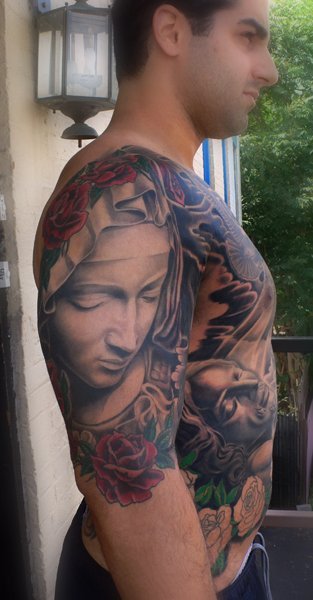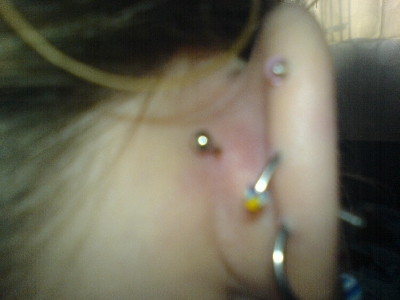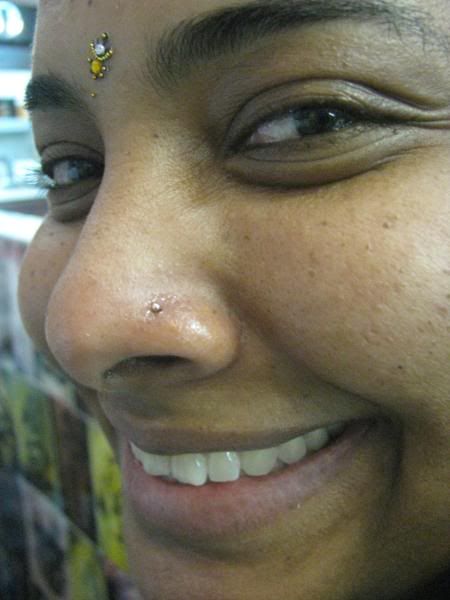
Body modification (or body alteration) is the deliberate altering of the human body for non-medical reasons, such as sexual enhancement, a rite of passage, aesthetic reasons, denoting affiliation, trust and loyalty, religious reasons, shock value, and self-expression.[1]. It can range from the socially acceptable decoration (e.g., pierced ears in many societies) to the religiously mandated (e.g., circumcision in a number of cultures), and everywhere in between. Body art is the modification of any part of the human body for artistic or aesthetic reasons.
Types of body modification
Explicit ornaments * Body piercing - permanent placement of jewelry through an artificial fistula; sometimes further modified by stretching
* Ear piercing - the most common type of body modification
* Dermal anchoring similar to transdermal implants, giving the appearance of a small bead on the skin [2]
* Pearling - also known as genital beading
* Neck rings
* Scrotal implants [3]
* Eyeball tattooing - Injection of a pigment into the cornea.
* Extraocular implant (eyeball jewelry) - The implantation of jewelry in the outer layer of the eye.
* Surface Piercing - A surface piercing is a piercing where the entrance and exit holes are pierced through the same flat area of skin.
* Tattooing - the mechanical placement of ink in the dermis
* Microdermal implants [4]
* Transdermal implant - implantation of an object below the dermis, but which exits the skin at one or more points
Surgical augmentationIn contrast to the explicit ornaments, the following procedures are primarily not meant to be exposed per se, but rather function to augment another part of the body, like the skin in a subdermal implant.
* Breast implants - Insertion of silicone bags filled with silicone gel or saline solution into the breasts to increase their size, or to restore a more normal appearance after surgery
* Silicone injection [5]
* Subdermal implant - implantation of an object that resides entirely below the dermis, including Horn implants [6]
Removal or split 
* Male circumcision - the partial or full removal of the foreskin, sometimes also the frenulum--conversely some men choose to take up foreskin restoration.
* Female genital cutting - removal of the labia minora or the clitoral hood
* Frenectomy [7]
* Genital bisection - splitting of both the underside and the top of the penis, including Genital inversion [8]
* Meatotomy - splitting of the underside of the glans penis
* Headsplitting - splitting of both the underside and the top of the glans penis
* Nipple removal [9]
* Nipple splitting [10]
* Nullification involves the voluntary removal of body parts. Body parts that are removed by those practicing body nullification are for example Fingers, Penis (penectomy), Testicles (castration), Clitoris, Labia or Nipples. Sometimes people who desire a nullification may be diagnosed with body integrity identity disorder or apotemnophilia.[11]
* Subincision - splitting of the underside of the penis, also called urethrotomy
* Lingual frenectomy [12]
* Tongue splitting - bisection of the tongue similar to a snake's
* Trepanation, drilling a hole into the skull [13][14][15]
Applying long-term forceBody modifications occurring as the end result of long term activities or practices
* Corsetry or tightlacing - binding of the waist and shaping of the torso
* Cranial binding - modification of the shape of infants' heads, now extremely rare
* Breast ironing - Pressing (sometimes with a heated object) the breasts of a pubescent female to prevent their growth.
* Foot binding - compression of the feet of girls to modify them for aesthetic reasons
* Anal stretching [16]
* Non-surgical elongation of organs by prolonged stretching using weights or spacing devices. Some cultural traditions prescribe for or encourage members of one sex (or both) to have one organ stretched till permanent re-dimensioning has occurred, such as:
o The 'giraffe-like' stretched necks (sometimes also other organs) of women among the Burmese Kayan tribe, the result of wearing brass coils around them. This compresses the collarbone and upper ribs but is not medically dangerous. It is a myth that removing the rings will cause the neck to 'flop'; Padaung women remove them regularly for cleaning etc.
o Stretched lip piercings - achieved by inserting ever larger plates, such as those made of clay used by some Amazonian tribes.
Others * Branding - controlled burning or cauterizing of tissue to encourage intentional scarring
* Ear shaping [17] (which includes Ear cropping [18], Ear pointing or "elfing" [19])
* Scarification - cutting or removal of dermis with the intent to encourage intentional scarring or keloiding
* Tooth filing [20]
* Bodybuilding
Controversy
The head of a man with conspicuous tattoos and other body modifications
Some sources of controversy stem from the notion of attempting to artificially beautify the natural form of the body, often leading to charges of disfigurement and mutilation. Extreme forms of body modification are occasionally viewed as symptomatic of body dysmorphic disorder, other mental illnesses, or as an expression of unchecked vanity[21]. Unlicensed surgery (i.e. the plastic surgery field) performed outside of a medical environment can often be life-threatening, and is illegal in most countries and states.
"Disfigurement" (a subjective term) and "mutilation" (regardless of any appreciation this always applies objectively whenever a bodily function is gravely diminished or lost, as with castration) are terms used by opponents of body modification to describe certain types of modifications, especially non-consensual ones. Those terms are used fairly uncontroversially to describe the victims of torture, who have endured damage to ears, eyes, feet, genitalia, hands, noses, teeth, and/or tongues, including amputation, burning, flagellation, piercing, skinning, and wheeling[citation needed]. "Genital mutilation" is also used somewhat more controversially to describe certain kinds of socially prescribed modifications to the genitals, such as circumcision, female circumcision, castration, and surgeries performed to conform the genitals of individuals with intersex conditions to those of typical males or females[citation needed].
 Body piercing literally means making a hole in a part of the human body with the purpose of wearing jewelry in the opening created. After a process of healing, a fistula will be created. This is an abnormal 'passageway' in your body or skin so that there's a genuine 'hole'.
Body piercing literally means making a hole in a part of the human body with the purpose of wearing jewelry in the opening created. After a process of healing, a fistula will be created. This is an abnormal 'passageway' in your body or skin so that there's a genuine 'hole'. This method is for larger gauge piercings and only works on body parts where the skin is very elastic. It's similar to the standard method, but after the hole is pierced with the needle, the piercer inserts a tapered steel bar (one of larger gauge then the needle) in order to make the opening bigger. The jewelry is directly inserted, following the tapered bar.
This method is for larger gauge piercings and only works on body parts where the skin is very elastic. It's similar to the standard method, but after the hole is pierced with the needle, the piercer inserts a tapered steel bar (one of larger gauge then the needle) in order to make the opening bigger. The jewelry is directly inserted, following the tapered bar.


































